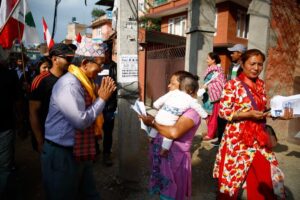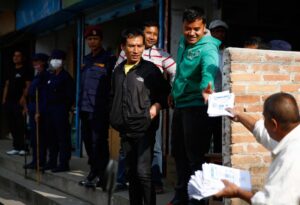May 3, 2023
Campaigning for local office in Nepal (Photo: Skanda Gautam / Himalayan Times)
For the first time since 2017, public optimism about the overall direction of Nepal has turned negative. In results just published in February, the 2022 round of our ongoing public opinion poll, A Survey of the Nepali People (SNP 2022), found that just 41% of Nepalis thought the country was going in the right direction, down from 65.6% in 2020, a discouraging decline from the cautious optimism of those earlier results.
Corruption, inflation, deteriorating economic conditions, and trouble finding work are the issues weighing most heavily on Nepalis. Just 20.7% report having a positive economic outlook, down from 40.1% in 2020. Political parties remain the institutions least trusted by the public. And although the survey results reflect public opinion only at the time of data collection, a confluence of national and international events over several years—including Covid-19, a series of national corruption scandals, and the rise of opportunistic electoral coalitions—are among the other likely contributors to this downturn in the national mood.
Yet, in an apparent paradox, respondents considering their circumstances at the local level revealed an optimistic outlook. The new local governments established by the 2015 Constitution, although their make-up is not yet fully inclusive of their diverse constituencies, appear to be gaining ground with a public that is becoming more familiar with their operations and more confident in their ability to govern and deliver services.
In SNP 2022, 54.4% of Nepalis said that the constitutional restructuring of 2015, which reduced the number of local governments from 4,000-plus to a total of 753 and increased their responsibilities, had improved government capacity to deliver services, compared to just 34.8% who said this in SNP 2017. The percentage of people who said it was “too soon to tell” decreased from 26.7% in 2017 to 3.9% in 2022.
A majority of respondents expressed a generally favorable opinion of local government. Trust of local government stands at 75.1%, and the share of Nepalis who report ease in obtaining local government services has continued to slowly grow over the years. Respondents named local governments as the most responsive actors during the Covid-19 pandemic, and overall satisfaction with local government services stands at 57.2%. Of those who contacted a local elected official in the last year, 49.3% said they were “satisfied” and 14.8% said they were “very satisfied” with the interaction or with the support they received.
SNP 2022 appears to support the general logic that local governments, being closer to their constituents, will be more responsive to their concerns. As a case in point, 54% of respondents said they were familiar with the services provided by their local government, while just 27.3% said the same of the federal government and 24.8% said so of their provincial government.
Campaigning in Nepal (Photo: The Asia Foundation)
Although, as we have noted, local elected leadership does not yet mirror the full diversity of Nepali communities, respondents in increasing numbers over the years have expressed the belief that an individual’s capabilities are more important than gender, caste, or ethnicity in fitting them for a leadership role. More than three-quarters of Nepalis in 2022 stated that men and women are equally capable of leading institutions and organizations, whether in government, business, or the community. With the exception of Muslims and Dalits, respondents reporting that their caste, ethnicity, or mother tongue hindered their access to public services or other social interactions, though still a majority, have also been decreasing in number. These are noteworthy shifts in public perception in this still deeply traditional society.
Nevertheless, these changing sentiments were not reflected in the results of local, provincial, and federal elections in May and November of last year. Meaningful participation in government by women and traditionally marginalized groups remains elusive, despite affirmative provisions of the new Constitution and measurable changes in the public’s stated beliefs.
A recent report by Dignity Initiative, a Nepali think tank, details the bleak status of women and other marginalized groups in the three tiers of government.
In the 275-member lower house of the federal parliament, 91 members are women. However, just 16 of the 275 belong to the Dalit caste, and 13 are ethnic Tharus, two of Nepal’s most marginalized groups. Even this meager representation would not have been possible without seat reservations under the 2015 Constitution, which mixes direct and proportional elections. Just nine women, one of whom is Tharu, and one Dalit man were directly elected, while the rest were nominated by their political parties under the proportional representation system.
Likewise, of 550 seats in the seven provincial assemblies, only 200, slightly more than one-third, are held by women, of which only 14 were elected directly. Just 31 seats, 5.5%, are held by Dalits, and only three of these, one in each of three provinces, were elected directly. Similarly, just 28 seats, 5%, are held by Tharus, and 18 of these were directly elected.
Finally, in Nepal’s 753 local governments, which are categorized as either municipalities or rural municipalities, the 2015 Constitution specifies that either the mayor or the deputy mayor, or the chair or vice chair in the case of rural municipalities, must be a woman. Some 568 women, 11 of them Dalits and 43 Tharus, were elected to the office of deputy mayor or vice chair in the last elections, but just 25 were elected mayor or chair, of which just one is a Tharu. And of Nepal’s 6,743 ward chairpersons, an elective office within the local government, only 69 were women, two of them Dalits and five Tharus.
These serious gaps in representation at all tiers of Nepali government call for serious reforms to mend the contradictions between optimistic public opinion and the dismal reality on the ground. Though Nepal has been remarkably successful in painting a rosy picture of political representation, with 33% women in the federal and provincial legislatures and 40% in local governments, a closer look suggests tokenism. This reflects the disappointing reality, mirrored in their selection of candidates, that most political parties, whose leadership across all levels is controlled by men, are still not ready to nominate women or marginalized groups to decisive leadership positions. It shows that the ladder to the top for aspiring women leaders is still determined not by their skills, commitment, or popularity, but by their networks, patronage relationships, and a host of other informal criteria. Despite the appearance of significant representation in all three tiers of government, a handful of women hold decisive positions only in local government.
One can still hope that these few courageous representatives who have broken the glass ceiling will push the boundaries of culture and politics to create conditions for better representation in the next round of elections. One can also hope that party structures will change to support more inclusive electoral slates. And perhaps national leadership will learn from local governments and local leaders, with their practical successes and growing public credibility, and take measures to restore their own flagging reputations before the next round of the Survey of the Nepali People.
Bishnu Adhikari is director of governance programs, Srijana Nepal is a senior program officer, and Rakshya Bhattachan is a program associate for The Asia Foundation in Nepal. They can be reached at bishnu.adhikari@asiafoundation.org, srijana.nepal@asiafoundation.org, and rakshya.bhattachan@asiafoundation.org respectively. The views and opinions expressed here are those of the authors, not those of The Asia Foundation.


